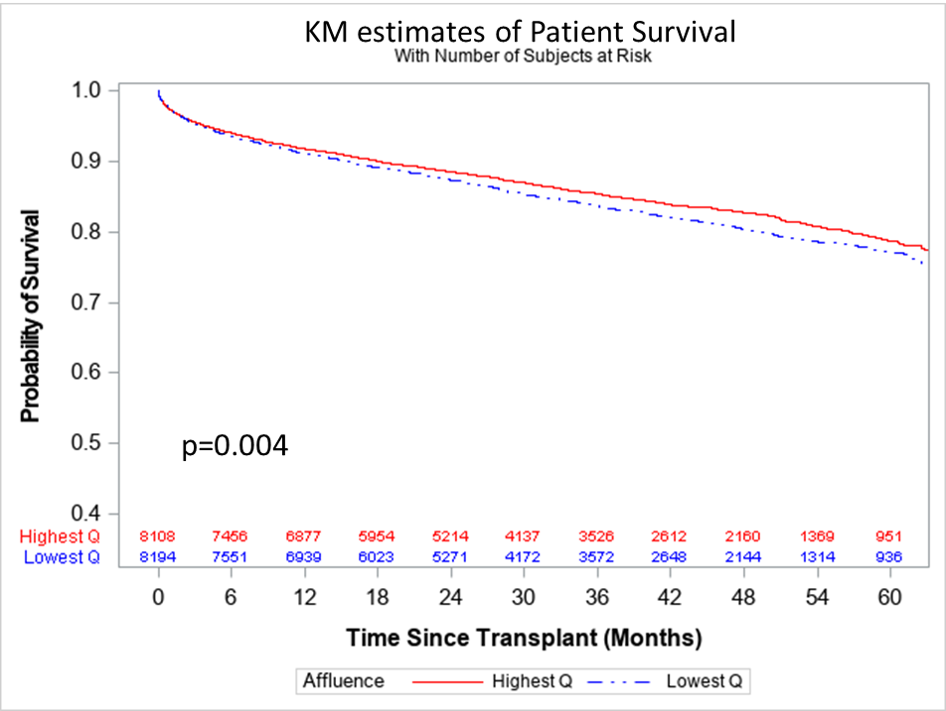Community Affluence Impacts Patient Survival Post Liver Transplantation
D. Jorgensen, A. Humar, C. Hughes, M. Molinari, A. Ganoza, S. Ganesh, A. Duarte-Rojo, A. Tevar
Surgery, University of Pittsburgh, Pittsburgh, PA
Meeting: 2020 American Transplant Congress
Abstract number: B-228
Keywords: Liver, Psychosocial, Risk factors, Survival
Session Information
Session Name: Poster Session B: Non-Organ Specific: Disparities to Outcome and Access to Healthcare
Session Type: Poster Session
Date: Saturday, May 30, 2020
Session Time: 3:15pm-4:00pm
 Presentation Time: 3:30pm-4:00pm
Presentation Time: 3:30pm-4:00pm
Location: Virtual
*Purpose: Liver transplantation is an effective treatment for patients with end stage liver disease with excellent patients and grafts long term outcomes. Many recipient disease and organ quality factors are known to adversely affect long term survival. Social determinants of health are known to affect a wide range of health, functioning, and quality-of-life outcomes. Little is known about the impact of social determinates of health on survival after liver transplantation.
*Methods: Data was analyzed from adult liver transplant recipients from the Scientific Registry of Transplant Recipients from January 1, 2013 to December 31, 2017. This data set was geographically matched using the recipient primary residence to the 2017 American Community Survey to examine if community factors impact patient and graft survival among liver transplant recipients. Using a Principal Component Analysis and the 5-year estimates from the 2017 American Community Survey, 58 measures of communities were combined into 4 community factors (affluence, middle class families, foreign-born/commuters, and impoverished). We then divided the communities into those in the highest and lowest quartile of each factor and examined patient and graft survival. Cox proportional hazards models were used to examine the risk of death post-transplant after adjusting for potential confounding factors.
*Results: Community affluence was found to be statically significant determinant of post-transplant survival in a Kaplan-Meier Analysis (p=0.004).
Recipients coming from communities in the highest quartile of affluence had a 10% lower risk of mortality post-transplant at 60 months (HR:0.9, 95%CI:0.83, 0.98; p=0.02), independent of recipient age, race, sex, education, meld at transplant, cold ischemia time, time of the waitlist, disease etiology, diabetes, and donor age.
*Conclusions: Community affluence has a small but significant impact on long term patient survival following liver transplantation. Further studies will look to investigate what specific community factors relate to this disparity and how to bridge the gap.
To cite this abstract in AMA style:
Jorgensen D, Humar A, Hughes C, Molinari M, Ganoza A, Ganesh S, Duarte-Rojo A, Tevar A. Community Affluence Impacts Patient Survival Post Liver Transplantation [abstract]. Am J Transplant. 2020; 20 (suppl 3). https://atcmeetingabstracts.com/abstract/community-affluence-impacts-patient-survival-post-liver-transplantation/. Accessed July 18, 2025.« Back to 2020 American Transplant Congress

